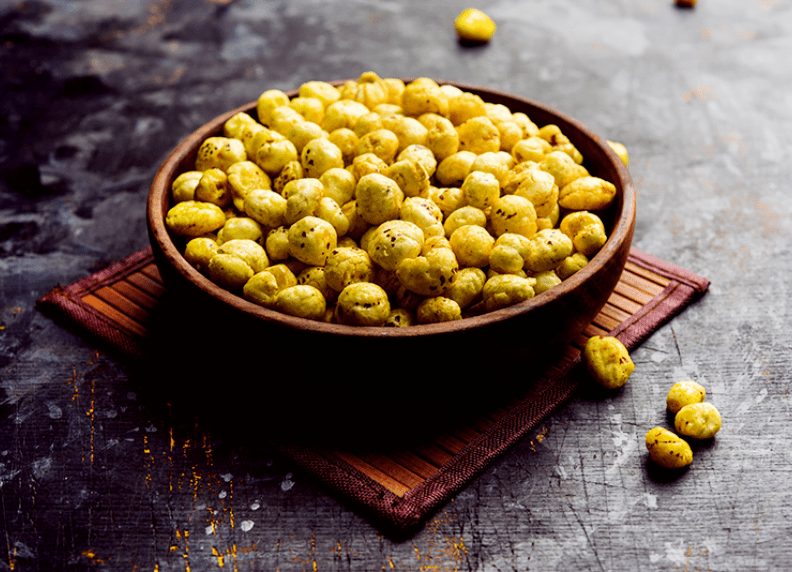Makhana Lifecycle: From Nature to Your Plate
The Superfood You Love – Naturally Nutritious & Delicious!
Makhana, also known as fox nuts, lotus seeds, or gorgon nuts, is an aquatic plant grown in water. It is a popular superfood cultivated mainly in India and other Asian countries. Packed with protein, fiber, and antioxidants, makhana is not just delicious but also highly nutritious. With a nutty flavor and crunchy texture, it serves as a healthy alternative to processed snacks.
From roasted munchies to flavored delights and even desserts, makhana is the perfect guilt-free snack for every occasion!

Profiling of the Makhana (Fox Nut) Plant
Makhana (Euryale ferox) is a perennial aquatic plant cultivated primarily in India, China, and other Asian countries. It belongs to the Nymphaeaceae family and thrives in stagnant water bodies such as ponds, lakes, and wetlands. The plant is known for its floating green leaves with a corrugated upper surface and deep purple underside, supported by stout, prickly ribs.
Plant Traits & Growth Conditions
| Plant Traits | Plant Attributes | Growth Condition |
|---|---|---|
| Type of Plant: Perennial & Water-based | Genus: Euryale | Requires 6+ hours of direct sunlight |
| Leaf characteristics: Deciduous | Species: Ferox | Prefers clay, silt, and sandy soil |
| Form of plant: Oval | Family: Nymphaeaceae | Requires soil pH <6 (acidic) or >8 (alkaline) |
| Primary Use: Seeds & Fruits | Propagation: By Seeds | Needs frequent standing water |
| Lifecycle: Perennial | Place of Origin: Northern & Eastern India, Russia, Far East | __ |
🌱 The Lifecycle of Makhana
Makhana (Euryale ferox) follows a unique growth and harvesting cycle, which involves specialized farming techniques to ensure high-quality production. The lifecycle can be divided into three main stages:
Stage 1: Makhana Cultivation
Traditional Pond System:
- Preparation: Clear the pond and broadcast healthy seeds.
- Maintenance: Thin overgrowth and fill gaps.
- Regeneration: Leftover seeds naturally sprout, reducing the need for re-broadcasting.
- Harvest: Collect seeds manually from the pond bed.
Field System:
- Field Preparation: Plough the field 2-3 times and fertilize using a 100:60:40 ratio of Nitrogen, Phosphorus, and Potassium.
- Flooding & Sowing: Flood the field with water (1.5 ft depth) and sow seeds in December.
- Seedling Care: Maintain a 1 ft water level from December to March for optimal growth.
- Transplanting: Move seedlings to the main field in early April at a spacing of 1.20 x 1.25 m.
- Regeneration & Investment: Leftover seeds can germinate on their own, minimizing additional investment.

Stage 2: Makhana Harvesting
In both pond and field systems, experienced fishermen carefully sweep the pond floor to form heaps of sunken seeds. They use a horn-shaped, split bamboo to scoop the seeds, while small nets help collect the lighter, smaller seeds. Once gathered, these heaps are thrashed by foot to remove the membranous cover. Notably, fields yield more per hectare and have a shorter harvesting cycle compared to traditional ponds.
Stage 3: Makhana Processing
Processing makhana involves a few straightforward steps:
Drying:
Seeds are spread out in the morning sun to reduce moisture and keep them fresh.Tempering:
The dried seeds are gently heated for 40 to 72 hours, ensuring they reach the right consistency for processing.Grading:
Seeds are sorted by size using sieves so that only uniform seeds move forward.Roasting & Popping:
The sorted seeds are roasted in cast-iron pans with continuous stirring. When the seeds start to crackle, they’re tested with a wooden hammer. This test makes the kernels pop open, and the outer shells are then removed by hand, leaving behind the light, crunchy snack.
With continuous research, government support, and the entry of new players in the makhana market, technology has revolutionized our processes. The mechanized popping method—encompassing threshing, cleaning, grading, drying, roasting, and popping—was developed and commercialized by ICAR-CIPHET, Ludhiana. This innovation has not only enhanced product quality for both domestic and international markets but also transformed the lives of thousands, ensuring better working conditions and sustainable livelihoods.
In conclusion, the journey of makhana—from traditional cultivation to advanced mechanized processing—embodies our commitment to quality, sustainability, and community empowerment. Experience the perfect blend of heritage and innovation with every bite of our premium makhana.
